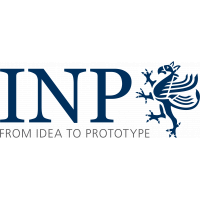This dataset contains plasma parameters of microarcs generated between a cooled copper anode and a ceriated tungsten cathode by means of a one-dimensional unified non-equilibrium model for gap lengths between 15 and 200 µm and current densities from 2x10^5 up to 10^6 A/m^2. The data show that the decrease of the gap length down to a few tens of micrometers for a given current density results in a progressive shrinking of the quasineutral bulk in the microplasma and its complete disappearance. The decrease of the gap length further leads to an increase of the discharge voltage and the electron temperature, and to slightly less heating of the gas.
| Field | Value |
|---|---|
| Group | |
| Authors | |
| Release Date | 2020-04-09 |
| Identifier | 81b91c12-ee67-405f-8c9b-27885f921590 |
| Permanent Identifier (DOI) | |
| Permanent Identifier (URI) | |
| Is supplementing | |
| Plasma Source Name | |
| Plasma Source Application | |
| Plasma Source Specification | |
| Plasma Source Properties | Microarc-plasma source in parallel-plate configuration including a cylindrical rod with a radius of 2 mm and a length of 20 mm made of ceriated Tungsten as the cathode and a copper anode. Current densities are varied in the range from 2x10^5 A/m^2 up to 10^6 A/m^2 and gap lengths of 15, 20, 50, 100, and 200 µm are investigated. |
| Plasma Source Procedure | The cathode end in contact with the plasma is heated by an effective heat flux, which includes contributions of ion bombardment and recombination, secondary and thermionic emission of electrons, plasma electrons reaching the cathode, and black-body radiation. The cathode end, which is not in a contact with the plasma, and the anode are kept at a constant temperature of 300 K. |
| Plasma Medium Name | |
| Plasma Medium Properties | Gas: pure argon, no gas flow; |
| Plasma Diagnostics Name | |
| Plasma Diagnostics Properties | Geometry: 1D |
| Plasma Diagnostics Procedure | The plasma is considered as a fluid containing electrons and heavy species of argon, namely ground state atoms, a group of 4s and 4p excited atoms, dimers, atomic and molecular ions, at atmospheric pressure. The computational model solves in one dimension the equations of particle and energy conservation for electrons and heavy species, the equation of heat conduction in the cathode, the Poisson equation for the electric potential, and an equation for the electric circuit, to which the electrodes are connected. Gas flow and self-induced magnetic field are not considered. |
| Language | English |
| License | |
| Public Access Level | Public |
| Contact Name | Baeva, Margarita |
| Contact Email |
Data and Resources
- Plasma parameters of microarcs towards minuscule discharge gap - Fig. 1csv
Voltage-current density characteristics for various gap lengths - see Fig. 1...
Preview Download - Plasma parameters of microarcs towards minuscule discharge gap - Fig. 2acsv
Spatial distribution of the degree of non-quasineutrality for the gap length...
Preview Download - Plasma parameters of microarcs towards minuscule discharge gap - Fig. 2bcsv
Spatial distribution of the degree of non-quasineutrality for the gap length...
Preview Download - Plasma parameters of microarcs towards minuscule discharge gap - Fig. 2ccsv
Spatial distribution of the degree of non-quasineutrality for the gap length...
Preview Download - Plasma parameters of microarcs towards minuscule discharge gap - Fig. 2dcsv
Spatial distribution of the degree of non-quasineutrality for the gap length...
Preview Download - Plasma parameters of microarcs towards minuscule discharge gap - Fig. 3acsv
Spatial distribution of the electron number density, the total ion number...
Preview Download - Plasma parameters of microarcs towards minuscule discharge gap - Fig. 3bcsv
Spatial distribution of the electron number density, the total ion number...
Preview Download - Plasma parameters of microarcs towards minuscule discharge gap - Fig. 4acsv
Spatial distribution of the electron temperature and the gas temperature for...
Preview Download - Plasma parameters of microarcs towards minuscule discharge gap - Fig. 4bcsv
Spatial distribution of the electron temperature and the gas temperature for...
Preview Download - Plasma parameters of microarcs towards minuscule discharge gap - Fig. 5acsv
Spatial distribution of the total ionization rate Rtot and its individual...
Preview Download - Plasma parameters of microarcs towards minuscule discharge gap - Fig. 5bcsv
Spatial distribution of the total ionization rate Rtot and its individual...
Preview Download

![[Open Data]](https://assets.okfn.org/images/ok_buttons/od_80x15_blue.png)